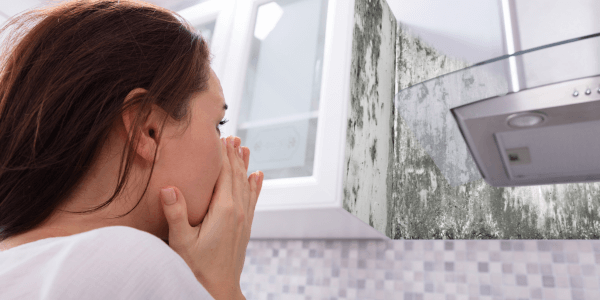Mold – the mere mention of it can send shivers down the spines of homeowners. And for good reason. Mold is not only unsightly, but it can also pose significant health risks.
Understanding the early signs of mold and acting on them is crucial to keeping your home and family safe. Here’s an insightful listicle to help you identify if mold is making an unwelcome appearance in your living space.
1. Musty Odors
Ever notice a musty smell in your home that you just can’t seem to place? It might be mold. Unlike other household odors, a musty scent is usually a strong indicator that mold is present.
Identifying Musty Smells
To zero in on these odors, start in areas where moisture is common – bathrooms, kitchens, and basements. Check for discoloration on surfaces; this often accompanies the odor.
What to Do if You Smell Mold?
Act quickly to identify and address the source of the moisture and the mold. Proper ventilation and dehumidification can be your first line of defense.
2. Visible Mold Growth
While not all mold is readily apparent, if you see it, you need to act. Mold can grow on any organic material, but it often appears on walls, ceiling tiles, or wallpaper as discoloration.
Taking on Visible Mold
Safety is paramount when removing mold. Wear protective gear, work in a well-ventilated area, and consider using a mild detergent for smaller patches. Larger infestations may require professional attention.
DIY vs. Professional Removal
Small, isolated areas of mold (less than about 10 square feet) can sometimes be addressed by the homeowner. However, if the mold growth is extensive or the area has been contaminated with sewage or floodwaters, it’s best to bring in professionals.
3. Water Leaks and Moisture Issues
Mold needs moisture to thrive, making water leaks a common precursor. Whether it’s a dripping pipe or a small pool of water on your basement floor, addressing these issues promptly can make a big difference.
Detecting Water Leaks
Water stains, peeling paint or wallpaper, and visible water are all signs that you might have a leak. Regular inspections of plumbing systems and roofing can help to catch issues early.
Fixing Moisture Problems
Never ignore a leak, no matter how small. Locate and repair the source, and then thoroughly dry the affected area to prevent mold growth.
4. Health Symptoms
Mold exposure can lead to a variety of health issues, from minor irritations to more severe allergies and even respiratory problems.
Recognizing Mold-related Health Symptoms
Be aware of symptoms like wheezing, red or itchy eyes, throat irritation, or skin rashes, particularly if they improve when you are away from your home.
Seeking Help
If you suspect mold is affecting your health, consult a medical professional. Additionally, an environmental consultant can test your home for mold spores if you suspect a serious problem.
Adding to the comprehensive list you’ve already compiled, here are more early signs of mold in your home that could enhance your blog post:
5. Allergic Reactions and Asthma Flare-ups
People sensitive to mold may experience allergic reactions or asthma attacks when exposed to mold spores in an environment. These reactions can be more pronounced during certain times of the day, especially at night when the house is less ventilated.
Identifying Allergy and Asthma Triggers
Monitor when and where these reactions are strongest in the home. This can help pinpoint mold-infested areas that might not be immediately visible.
Mitigating Allergic Reactions
Improving air quality through better ventilation, using air purifiers, and ensuring regular cleaning can help reduce the presence of mold spores in the air.
6. Peeling, Cracking, or Warping of Paint and Wallpaper
Mold can cause paint and wallpaper to lose adherence to walls, leading to peeling, cracking, or warping. This sign is often overlooked as mere cosmetic damage but can indicate a deeper issue with mold growth behind walls.
Spotting Paint and Wallpaper Damage
Look for uneven surfaces, bubbling paint, or wallpaper that’s coming loose. These can all suggest the presence of moisture and, potentially, mold.
Addressing Wall Damage
Investigate any damaged areas for underlying leaks or moisture. Removing the affected material and repairing the moisture source is crucial to prevent further mold growth.
7. Frequent Condensation
High levels of humidity in the home can lead to condensation on windows, pipes, and other cold surfaces. This persistent moisture creates an ideal environment for mold to flourish.
Recognizing Problematic Condensation
Notice if certain areas of your home frequently have beads of water on surfaces, which can signal excessive indoor humidity.
Controlling Indoor Humidity
Use dehumidifiers in humid areas, ensure proper ventilation throughout the home, and address any issues causing excess moisture, such as leaky windows or pipes.
8. Rusting Indoor Metal Surfaces
Rusting on indoor metal surfaces, like vents, pipes, or window frames, is an indirect sign of potential mold growth. The excess moisture required for rust to form can also support mold development.
Detecting Rust as a Mold Indicator
Check metal surfaces regularly for signs of rust, especially in areas known for higher moisture levels.
Preventing Rust and Mold
Improve air circulation, reduce indoor humidity, and promptly repair any water leaks to keep both rust and mold at bay.
Prevention Techniques
Preventing mold growth in the first place is the most effective strategy.
Routine Maintenance Matters
Keep your home well-maintained. Regular cleaning, inspecting for leaks, and ensuring good ventilation can go a long way in preventing mold.
Smart Landscaping
Directing rainwater away from your home’s foundation can help prevent dampness in basements and crawl spaces.
Professional Inspection for Signs of Mold
At Rawk J Services, we understand the importance of maintaining a mold-free environment in your home. Mold can not only damage your property but also pose significant health risks to you and your family.
That’s why we advocate for proactive measures, including professional inspections, to ensure your living space remains safe and healthy. Here’s our advice on navigating professional mold inspections:
Choosing an Inspector
Selecting the right inspector is crucial. Ensure that the professional you hire is not only qualified but also has extensive experience in mold detection.
A reputable inspector will provide you with a thorough assessment of your home, pinpointing any signs of mold. Following the inspection, you should receive a comprehensive report detailing their findings, along with recommendations for remediation if necessary.
At Rawk J Services, we maintain a network of trusted inspectors known for their expertise and reliability.
Regular Repeat Inspections
Mold can be sneaky, reappearing when least expected. To keep your home mold-free throughout the year, we recommend scheduling regular inspections.
Don’t wait for visible signs of mold to emerge; by then, the problem could have already caused considerable damage. Regular inspections are key to early detection and effective prevention.
Be Proactive to Beat Mold
Recognizing the early signs of mold growth is crucial in protecting both your home and your loved ones. Musty smells, visible mold, water leaks, and health symptoms are all warning signals that demand your attention.
Key steps to maintaining a safe, mold-free living space are taking action at the first indication of mold, implementing preventive strategies, and enlisting professional assistance when necessary.
At Rawk J Services, we’re here to support you in this endeavor. Remember, vigilance is your best defense against mold. Don’t wait for mold to become a bigger problem; contact Rawk J Services today and let us help you ensure your home remains a healthy sanctuary for you and your family.

